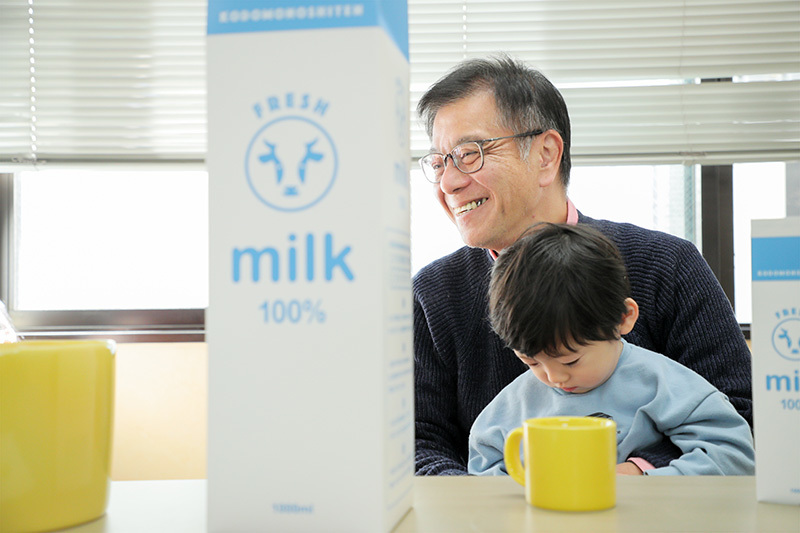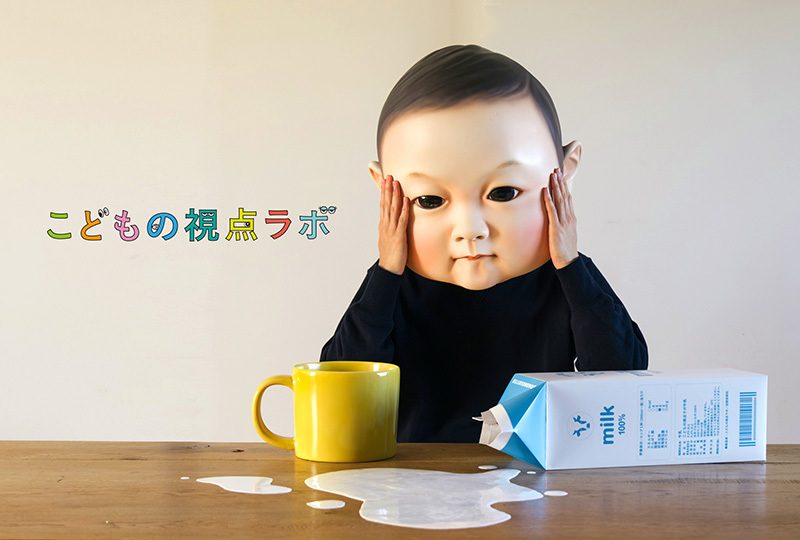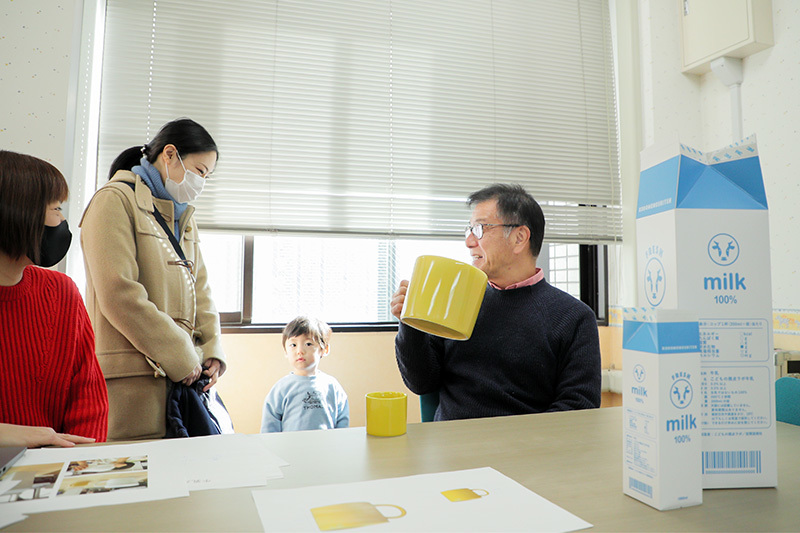The "Child's Perspective Lab" seriously and enjoyably researches what the "first-person perspective" of babies and toddlers is like. Last time, we experienced the size of a baby's head, which is about four times the size of their body.
This time, continuing our collaboration with Professor Kazuo Kai from the University of Tokyo's Baby Lab, we want to explore the "size from a child's perspective."
When children spill drinks, we often get frustrated thinking, "Oh no, not again!" But how big are cups and milk bottles when actually held in a child's hands?
An adult experiences a 2-year-old's palm
Kutsukake: Professor, we made the cup and milk we discussed earlier, based on the idea of "What if an adult became a 2-year-old's palm?"
Professor Kai (hereafter, Professor): Huh, it's this big? Can I hold it for a moment? It's quite heavy, isn't it?
Kutsukake: My child's palm size at age 2 was 10 cm. Since the average Japanese male palm size is 18.3 cm (*), I made it 1.83 times that size.

※Source: Kawachi Makiko, 2012: AIST Japanese Hand Measurement Data
Professor: I see. You know how little kids often spill their drinks mid-sip? Now I understand why. Drinking from this must be really tough. Actually holding it myself made me realize that. This is interesting~.
Ishida: Honestly, I was surprised too—I hadn't realized it was this big. Right now, the cup is filled with silicone, but in reality, it would be filled with liquid sloshing around.
Professor: If someone told you to drink from this... Well, it's no wonder kids spill it, huh? (laughs)
Ishida: Yeah, you're absolutely right.
Kutsukake: Also, regarding the milk carton, they actually made it with about half the liquid inside. When you try to carry it like this, the movement of the liquid inside feels really heavy because of the size. It made me think again, "No wonder it spills easily. I have to be careful not to get angry."
Teacher: Wow, this is tough. But experiencing it like this is really good. It's truly important.
Ishida: When we consulted you before production, you mentioned that while size could be determined simply by scale, weight is harder to calculate uniformly because it involves hand strength and muscle power.
Teacher: That's right. Arm length, muscle strength, hand grip strength—all these factors differ from adults.
Ishida: They say newborns have enough grip strength to hang onto something if you let them grasp it. They seem incredibly strong. Does that strength disappear around age two?
Professor: I think it's about the relationship between muscle strength and body weight. Newborns are very light, right? Then babies gradually gain weight.
Ishida: So as they get heavier, they can't support themselves anymore.
Teacher: Exactly. Have you heard of "primitive walking"? If you hold a newborn upright, they'll take little steps forward, like they're walking. But after about one or two months, that response disappears. Why does this innate rhythmic movement ability vanish? It's probably because they gain weight.
It's also related to muscle strength; they get too heavy to take steps. To investigate whether body weight is the cause, there's a famous experiment where babies were placed in a large tank where buoyancy made their bodies lighter. In that environment, they showed walking-like movements again.
Ishida: Huh, that's interesting.
(Here, the professor's secretary's child, Hiro-chan, appears)
Professor: Oh, Hiro-chan's here. He's two now.
Ishida: If you give him a regular-sized cup, it's definitely too big for him, right?
Professor: Adults have experience gripping many things repeatedly, so they know how to hold things, right? How you hook your fingers around a cup, how you grip and hold it—it all changes depending on the size and shape. That's surprisingly complex, isn't it?
Ishida: Absolutely! For toddlers, everything is something they've never seen or held before. If we suddenly saw a huge container with strange protrusions in an unfamiliar shape, we wouldn't know how to hold it either, right?
What if an adult became a child and met another adult?
Kutsukake: Household items are pretty big too, but I figured adults themselves must seem enormous to children, so I made this illustration. For a child 75 cm tall, an adult 180 cm tall is 2.4 times their height. If we assume an adult 180 cm tall is a child, that adult would be a whopping 432 cm (180 × 2.4).
Teacher: Being talked down to by a 4-meter-tall person would be pretty intimidating (laughs).
Ishida: They'd be like a giant, right? It really made me think I shouldn't get angry while standing over them. I tend to do it anyway, though.

Teacher: Look at the chair here with Hiro-kun. See how the seat is around chest height? Climbing up to sit on it is pretty amazing.
Kutsukake: Climbing stairs must be tough too.
Teacher: That's right. You have to use your whole body to climb steps that are higher than your knees.
Ishida: I couldn't do that.
Teacher: Wouldn't it be interesting to try making something like that?
Ishida: If I get the chance, I'd love to try making one. "Becoming a Child and Trying to Climb the Stairs." It looks incredibly tough! I'd also like to think about building a house from a child's perspective.
Teacher: That's great—building a house that's safe for children. But if you do it, I think it's important to balance that with "fun." If it's only safe, kids will find it incredibly boring.
Kutsukake: Design from a child's perspective that children can enjoy.
Teacher: Exactly. That was also the theme when I created a picture book from a baby's perspective (※2). Design, everything is made from an adult's perspective, right? Picture books are also conceived by adults thinking they know what's best. I wanted to incorporate a baby's way of thinking into that creation process. I can't explain why this shape appeals to babies. I can't explain it. But that's the point. I wanted to experiment with including babies in judging the quality of design.
Kutsukake: Design incorporating a baby's perspective sounds really interesting. I'd like to try it myself.
※2 Picture book reflecting babies' preferences: "Moi Moi" (Written by Jun Ichihara, Supervised by Kazuo Kai / Discover Twenty-One)

(Interview photography: Hayato Onimaru)
This research and interview also yielded various discoveries.
● Toddlers handle objects nearly twice their size every day. That alone is tough!
● We should remember that for toddlers, the very experience of "holding" and "grasping" things is entirely new. (I need to remember not to get angry when they fail. Sweat)
● From a toddler's perspective, adults look like giants over 4 meters tall. We should talk while bending down to meet their eye level, not standing upright. Also, the point that almost everything is designed from an adult's viewpoint was very striking. If we can incorporate a child's perspective into this, it seems like a new form of universal design could emerge.
Finally, using this project, we created a concept video for the "Child's Perspective Lab." What happens when a toddler pours milk? Please watch the one-take masterpiece by Kutsukake-kun's son, Haruta-kun.

















